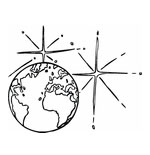
Three Critical Moments in the History of the Cosmos
THE SEEDS OF GOD
About a month ago, I was in a casual conversation with a former student who said that though he accepts Christianity in most fundamental points, the Eucharist is a teaching about which he is still unsure. His exact wording was that he didn’t know “how that would work.” His comment set me to musing about the many things the workings of which I am totally ignorant. Perhaps my poor educational background explains why I don’t know what fire is, or gravity, or light. However, if I were to shy away from the benefits of these and other things merely because I don’t know how they work, my comings and goings in this world would be severely handicapped.
There are certain mysteries, natural and supernatural, that consistently resist the firm grip of the human mind. Our acceptance of these ideas, however, is not based on cognitive mastery of all the details therein but on the fact that they seem to correspond to a certain pattern of experience. British scientist Arthur Eddington, for example, set up an experiment in 1919 that demonstrated rather convincingly that there are curvatures in the fabric of space. Wait — curvatures in what? The fabric of space? Spacetime? This is all completely beyond us, yet we do know that if we stretch out a bed sheet and put a tennis ball in its center, anything we roll across that sheet will be attracted to the depression caused by the ball. We have, then, a certain experience that helps us “understand” curvatures in spacetime and the theory of relativity.
I sympathize with my student in that I, too, don’t know how the Eucharist works. Nevertheless, I do find that it fits into a certain pattern — a pattern of history and science. It is a pattern of singularities, of small things appearing out of nowhere and becoming very big things. I think we can put the Eucharist in line with three critical moments in the history of our cosmos. We can call them critical moments of life, having to do with: first, the creation of the universe; second, the creation of life on Earth; and finally, the relatively sudden appearance in Homo sapiens of a transcendent capacity — a capacity some might identify simply as the soul. For each of these events, science can trace back a certain sequence of effects, but it stops, baffled, in consideration of a final cause of those effects. These three critical moments have two shared characteristics: first, each emerges from a singularity, meaning a small, primary point of origin; second, each singularity seems to sort of pop into existence, apparently lacking any preceding causation. It’s as though each event, each singularity, were created from nothing.
You May Also Enjoy
The way we think about time has changed dramatically over five centuries. Time isn’t just a constant, a marked-off measure. It allows for the creation of whole worlds.
Only a minority of believers who have entered into communion with the Albigenses and the Darwinists have ever managed to escape their labyrinths.
Prum's study advances the claim that much extraordinary avian morphology and behavior is best explained as a factor of female desire and mate selection.

